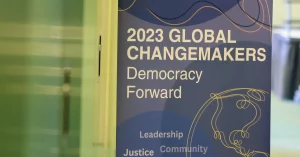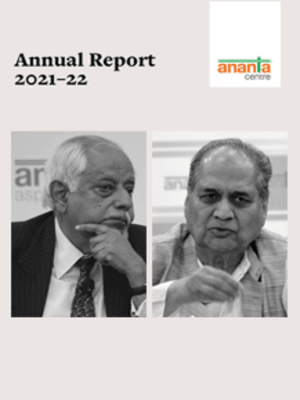HIGHLIGHTS
• Indian economy’s contraction in 2020-21 revised down
• April-June 2020 saw India’s worst decline in economic output
• Agriculture bucked the overall decline in many sectors
• Construction led the recovery from third quarter
• Services remained in contraction mode for the whole of 2020-21
• Growth forecast for 2021-22 lowered by World Bank, RBI
• Sharp variations in Govt’s tax revenue estimates
• Actual tax revenues fell 10-12 % over RE in 2018-19 & 2019-20
• Actual tax revenues up 6 % over RE for 2020-21
• Prudence and pragmatism in reducing food subsidies burden
• Indirect taxes race ahead of direct taxes
• No escape from divergence in actuals and revised estimates
• RBI prioritises growth over inflation; no change in interest rate
• With more buying of govt securities, bond yields stabilise
• GST collections may fall in July, but should look up in August
• Sharp rise in e-way bills in first 3 weeks of June
• Exports maintain healthy growth in May
• Trade deficit dips to an eight-month low
Indian economy’s contraction in 2020-21 revised down
Two sets of economic growth numbers for India were released by the National Statistical Office at the end of May. Both the data points showed that the Indian economy fared a little better than what was presumed earlier. Going by the gross domestic product (GDP) numbers, released earlier in February 2021, the pace of economic activity in the fourth quarter of 2020-21 was expected to slip back into contraction mode with an output decline of about 1.14 per cent. But the latest data on the January-March quarter of 2021 show that the GDP had shown no contraction then. Instead, it had shown a rise of 1.6 per cent. This obviously had a positive impact on the annual GDP figure for 2020-21. Earlier, the annual contraction was expected to be about 8 per cent. The latest estimate puts it at a contraction of 7.3 per cent.
April-June 2020 saw India’s worst decline in economic output
With the release of the GDP data for all the quarters of 2020-21, it is now possible to map the extent of the adverse impact of the Covid-19 pandemic and the economic lockdown on the pace of economic activity in the four quarters of 2020-21. The first quarter was impacted by the complete national lockdown that had been imposed from March 24 to May 31. There was phased relaxation of the lockdown at a slow pace from June 1 onwards, but the April-June 2020 quarter was completely washed out by the pandemic-induced lockdown. At the aggregate level, India recorded its worst economic performance at a GDP contraction of 24.4 per cent.
Agriculture bucked the overall decline in many sectors
A sectoral analysis shows that the construction sector suffered the most with a contraction of about 50 per cent, followed by the services sector (trade, hotels, transport, communication, etc.) with output declining by 48 per cent and manufacturing at 36 per cent contraction. Mining and quarrying activities also suffered with an output decline of over 17 per cent. Public administration and defence (a proxy for government spending) dipped by over 10 per cent, closely followed by electricity. Significantly, financial services and real estate in the first quarter of 2020-21 had a relatively mild contraction of 5 per cent. But the sector that bucked the overall trend was agriculture, whose output rose by 3.5 per cent.
Construction led the recovery from third quarter
The GDP numbers for the second, third and fourth quarters of 2020-21 showed that economic activity began recovering at a slow pace. While the second quarter continued to contract by 7.4 per cent, the third and fourth quarters saw an improvement with GDP growth returning at 0.5 per cent and 1.6 per cent, respectively. But the sectoral recovery was uneven and even patchy. For instance, the construction sector made the smartest recovery by restricting its contraction to just 7.2 per cent in the second quarter and then posting healthy growth at 6.5 per cent and 14.5 per cent in the third and fourth quarter, respectively. Electricity too recovered quickly, with the last three quarters of 2020-21 showing output in the positive territory. Manufacturing and the financial services as well as real estate bounced back with growth in the final two quarters.
Services remained in contraction mode for the whole of 2020-21
In contrast, the services sector (trade, hotels, transport, communication, etc.) remained in contraction zone right through all the quarters of 2020-21, with output declining by 48 per cent, 16 per cent, 8 per cent and 2 per cent in the four quarters, respectively. Mining and quarrying also remained in contraction right through last financial year. Even public administration and defence had a prolonged contraction phase lasting till the third quarter of 2020-21. Clearly, the pandemic, the economic lockdown and its relaxation had sharply varying impacts on different sectors of the economy.
Growth forecast for 2021-22 lowered by World Bank, RBI
The growth forecast for 2021-22, however, continued to be revised downwards. Soon after the Reserve Bank of India scaled down GDP growth for the current year from its earlier estimate of 10.5 per cent to 9.5 per cent, the World Bank cut India’s growth forecast to 8.3 per cent. Earlier, the World Bank had pegged India’s growth in 2021-22 at 10.1 per cent. What led to this downward revision? Predictably, it is the impact of the second wave of Covid-19 that pulled down the pace of economic activity in the first quarter of the current year and the fear of a third wave of the pandemic emerging later in the year. “India’s recovery is being hampered by the largest outbreak of any country since the beginning of the pandemic,” the World Bank noted in its latest issue of Global Economic Prospects. What can help expedite the Indian economy’s recovery? According to the World Bank, policy support, including higher spending on infrastructure, rural economy and health, aided by a policy boost for services and manufacturing, would be crucial.
Sharp variations in Govt’s tax revenue estimates
There was some relief in North Block, headquarters of the finance ministry, when the provisional actuals for government finances in 2020-21 were released last month. For two years running, the provisional actuals for 2018-19 and 2019-20 showed that the government had overestimated its tax revenues. The figures on tax revenues, presented to Parliament in February 2019 and 2020 had to be scaled down just about four months later, making a mockery of the system of releasing the revised estimates at the time of presenting the annual Budget. The revised estimates for tax revenues in 2020-21, presented to Parliament in February 2021, marked a difference. The revised estimates (RE) had to be revised upwards as the provisional actuals pegged them at a higher level, providing some relief to the government’s fiscal deficit for last year.
Actual tax revenues fell 10-12 % over RE in 2018-19 & 2019-20
In 2018-19, the net tax revenue for the Centre was Rs 13.67 lakh crore according to the revised estimates (RE) presented in February 2019. But by June 2019, the provisional actuals showed the net tax revenue at about Rs 12 lakh crore, a decline of over 12 per cent. To absorb the shortfall, the government adopted a mix of innovative and controversial accounting measures, which consequently helped dress up the government finances and retained the deficit number as projected earlier. In 2019-20 also, the Union government’s net tax revenue was estimated at Rs 15 lakh crore as per the revised estimates in February 2020. But four months later, the provisional actuals scaled them down by about 10 per cent to Rs 13.56 lakh crore. Higher borrowings and marginal cuts in expenditure followed, which eventually raised the actual fiscal deficit.
Actual tax revenues up 6 % over RE for 2020-21
For 2020-21, the provisional actuals, released last month, showed that the government’s net tax revenues were Rs 14.24 lakh crore, 6 per cent more than the Rs 13.44 lakh crore provided in the revised estimates placed before Parliament in February 2021. This increase in revenues was bolstered by a reduction in expenditure, providing an unexpected additional fiscal cushion of around 1 per cent of GDP. This provided an easy and populist option to the government: Use the cushion to show a fiscal deficit that is lower than what was presented to Parliament in February – 9.5 per cent of GDP.
Prudence and pragmatism in reducing food subsidies burden
Prudence and pragmatism guided the finance ministry in handling the surplus tax revenues it had collected in 2020-21. It used a large part of the excess amount to prepay the dues to the Food Corporation of India under the food subsidies head. This helped it plan ahead for next year – its fiscal burden in clearing FCI’s dues would be reduced and the need for extra-Budget borrowings would be less or even nil. The excess revenue that was still left with the government was used to reduce the fiscal deficit, which as per the provisional actuals declined to 9.2 per cent of GDP, compared to the earlier revised estimate of 9.5 per cent. The reduction, of course, was aided by the revised nominal size of the Indian economy, which for 2020-21 was now estimated at Rs 197 lakh crore, instead of the earlier figure of Rs 195 lakh crore.
Indirect taxes race ahead of direct taxes
There were still some worrying features evident in the provisional actuals. The new tax revenue numbers brought out clearly how the government’s reliance on indirect taxes was on the rise. A few years ago, the share of direct taxes in total government tax revenues was about 52 per cent and indirect taxes contributed the rest i.e. about 48 per cent. That equation reversed in 2020-21, with direct taxes accounting for about 46 per cent of the Centre’s total tax revenues and the remaining being contributed by indirect taxes. A rising dependence on indirect taxes is not a healthy development as such taxes are regressive and inequitable.
No escape from divergence in actuals and revised estimates
The other worry point was that the divergence between the provisional actuals and the revised estimate of the tax revenues continued to underline weaknesses in the estimation procedures followed by the finance ministry. A divergence of about 6 to 12 per cent between the revised estimate and provisional actuals calls for corrective steps to evolve a robust system of arriving at realistic estimates. In 2020-21, the variations worked to the benefit of the finance ministry. But as was seen in the previous two years, the variations had then caused avoidable fiscal management problems.
RBI prioritises growth over inflation; no change in interest rate
In its bi-monthly review held in the first week of June, the Monetary Policy Committee of the Reserve Bank of India sprang no surprise by announcing that it had unanimously decided to keep the repo rate (the rate at which banks can borrow from the central bank) at 4 per cent. More importantly, it maintained its stance as “accommodative” as long as it would be necessary to revive and sustain growth on a durable basis. Inflation management was a concern, but it clearly became a secondary area of focus for the RBI. While prioritising growth over controlling inflation, the RBI clearly moved in a new direction. The Committee was of the view that at this time, there was an urgent need for policy support from all sides to help the Indian economy regain the momentum of growth, signs of which were becoming visible. In its assessment of the state of the economy, it had already scaled down its projections of growth for the current year – down from 10.5 per cent earlier to 9.5 per cent.
With more buying of govt securities, bond yields stabilise
The Committee also stepped up the pace of its purchase of government securities under the government securities acquisition programme (G-SAP), its own version of quantitative easing to maintain liquidity in the system. It announced the purchase of Rs 1.2 lakh crore more bonds in the second quarter of 2021-22. In the first quarter, it had planned to buy bonds worth Rs 1 lakh crore. The move kept the local bond investors happy as the bond yields stayed range-bound at around 6 per cent. Equally comforting was the foreign exchange reserves situation, which rose to a new high, hovering at around $600 billion.
GST collections may fall in July, but should look up in August
There are good tidings on the Goods and Services Tax (GST) front. GST collections in May had fallen to just about Rs 1 lakh crore. Though this was above the Rs 1 lakh crore-mark for the eighth month running, it was a decline from the record April collections figure of Rs 1.41 lakh crore. Remember that the April figures reflected the transactions that took place in March 2021. In other words, the localized lockdowns in the wake of the second wave of Covid-19 from April onwards impacted transactions in April and the collections for May reflected the lower figure of Rs 1 lakh crore. The collections in June are expected to fall further as they would reflect the loss in the pace of economic activity because of the second wave of Covid-19 in May.
Sharp rise in e-way bills in first 3 weeks of June
But what gives reason for some cheer is the well-established correlation between e-way bill generation and GST collections. E-way bills are to be mandatorily generated for all transported goods with a transaction value of over Rs 50,000. Thus, the number of e-way bills generated in a month or a week gives an indication of the amount of GST collected by the authorities. For instance, e-way bills generation stood at 67.2 million in March, resulting in a record level of GST collections in April. In April, e-way bills generation fell to 57.3 million, which led to a drop in GST collections to just about Rs 1 lakh crore in May. The e-way bills generation in May had dropped to just 39.5 million, suggesting that the June collections of GST, to be out on July 1, would show a big fall. However, the trend of e-way generation has changed for the better in June. E-way bills generated in the first three weeks of June rose to 32.8 million, compared to 24.5 million in the same period of May. This clearly suggests that GST collections will see a rise in July. For the exchequer, this would be good news in August.
Exports maintain healthy growth in May
Maintaining an uptrend in India’s foreign trade witnessed in the last few months, the merchandise exports figures showed healthy growth at $32.27 billion for May 202. The year-on-year growth was over 69 per cent, which of course was because of the low base effect. Exports in May 2020 had collapsed because of the economic lockdown in the wake of Covid-19. But even when compared with exports in May 2019, the performance this year represents an increase of over 8 per cent. Sequentially, May 2021 exports were a little over 5 per cent more than what they were in the previous month. What drove the rise in merchandise exports were petroleum goods (remember that there has been a rise in their international prices), engineering goods, gems and jewellery. India’s merchandise imports too saw a huge jump in May 2021, at $38.55 billion – an increase of over 73 per cent, which was once again a result of a low-base effect.
Trade deficit dips to an eight-month low
India’s trade deficit reached an eight-month low at $6.28 billion in May 2021. This was attributed to increasing state-level restrictions in the wake of the second wave that restrained imports, particularly of crude oil and gold. However, exports were not unduly affected by localized lockdowns as there was a significant increase in external demand for goods, with the opening up of developed economies. The unit value realization also improved, contributing to the growth in the value of exports. The revival of global trade is a positive sign for India’s merchandise exports. According to Sharad Kumar Saraf, President of the Federation of Indian Export Organisations,“the continuing impressive growth in May 2020 reiterate our assessment that order booking position of our exporters is not only extremely good but also the gradual opening up of major global markets and improvement of situation in the country are expected to push exports growth further.” But the full advantage of such a situation can be taken only if policies are geared to providing support to Indian exports in terms of procedural and policy facilitation, financial packages and bank credit availability.
Supported by
………………………………………………………………………………………………
(The views expressed are personal)
………………………………………………………………………………………………

























